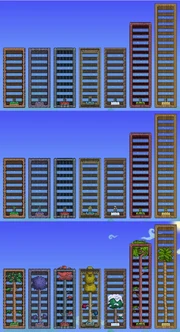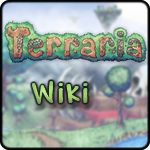All tree types. From left to right: Forest, Corruption, Crimson, Hallow, Snow, Beach, Jungle/Underground Jungle, Mushroom.
Trees are the largest plants in Terraria, appearing mostly at the surface and often in clusters with similar height. Trees can be chopped down with an axe, with the use of explosives, or by pouring lava on the base. Destroying or chopping a tree will yield many units of wood, an essential crafting material, and give a chance of dropping one or more acorns that can be planted to grow more trees. Larger trees will yield more of these two materials when removed, since the amount of wood and acorns obtained from a tree depends on its size: one unit of wood will drop for each block of tree (including branches), and one acorn may drop for each leaf patch, excluding the top patch of leaves. It is possible to cut off parts of the tree, but cutting at the lowermost center tile will destroy the entire tree. If parts of the tree are left, they will not regrow. Tiles beneath trees cannot be destroyed while the tree stands.
Trees as obstacles
With the exception of Living Trees (discussed further below), trees are background objects that do not affect player or monster movement.
Trees cannot be climbed or scaled with items such as a grappling hook, nor can blocks of dirt or other walk-on surfaces be placed to overlap their limbs or foliage (it is possible however, to attach platforms to the trunk of a tree). It can sometimes be necessary to chop down a tree that is next to a cavern entrance or cliff in the early game in order to replace it with a ladder of blocks that will allow scaling of the steep surface; this becomes unnecessary when the player obtains a grappling hook, Climbing Claws or other items that allows improved jumping or flying.
Trees must be removed when building houses that overlap the space they cover or when digging up from underground to exit to the surface.
Growing conditions

Newly planted Saplings, left to right: Forest, Corrupt, Crimson, Hallow, Boreal, Jungle, Palm

The smallest enclosures allowed for growing trees: without saplings (top), planted saplings (middle), grown trees (bottom).
Planting an acorn in grass will create a Sapling that will eventually grow into a tree of a random size and shape. Saplings can only grow under the following conditions:
- An acorn can only be planted on grass, corrupt grass, crimson grass, hallowed grass, jungle grass, snow, or sand. Acorns cannot be planted on mushroom grass, but a giant glowing mushroom may grow spontaneously if all other conditions are met.
- The acorn requires one horizontal space of open ground to either side below it, but at least two unobstructed tiles to the left and right of it.
- There must be at least three open tiles between saplings or only one will grow into a tree. This matches the previous rule, i.e. each acorn needs both adjacent tiles free, which means the closest two trees can be is with three tiles between them.
- Most saplings require at least 16 tiles of vertical clearance (32 feet by a Depth Meter) to grow into a tree, including the tile the sapling occupies. Jungle trees require 24 tiles, and palm trees require 30 tiles. Even when there is sufficient space, a tree may sometimes be tall enough to clip through the roof.
- Most saplings will grow indoors as long as there is either fence or no wall immediately behind the sapling; unlike other saplings, palm trees will not grow in front of fences. All other walls are ignored.
- Saplings will not grow in the presence of torches, platforms, sunflowers or most other foreground objects within its 2-block radius, with the exception of small grass and flower plants. Dye plants and mushrooms can occasionally sprout next to a sapling and prevent its growth, but harvesting the blocking item will still allow the sapling to grow into a tree.
- A sapling needs to be above surface level. Acorns planted on grass underground or below will not grow, even if all other conditions are met.
- Template:Pc icon On the PC version, trees update the map data automatically so it's possible to spot tree growth on the minimap or full screen map without needing to approach the sapling.
- Template:Console iconTemplate:Mobile icon On Console and Mobile, saplings must be off-screen in order to become trees. They will not grow when currently in view, unlike most other plants which can spawn while you watch.
Saplings can be destroyed with a Pickaxe, but will not yield acorns.
Variants
Forest trees
Forest trees are the most common type. They yield regular Wood when harvested. Many Forest trees eventually turn into Corrupted, Crimson or Hallowed ones when the area they grow on is overtaken by these biomes.
This variant has also 6 different appearances depending the area and the world you are on.
Corrupt & Crimson trees
Corrupt trees are purple trees only found where there is Corruption. They behave like normal trees, but drop Ebonwood. They are converted from normal trees when corruption spreads upon them. Crimson trees are red trees only found where there is Crimson. They behave like normal trees, but drop Shadewood. They are converted from normal trees when crimson spreads upon them. It is possible to convert both into normal trees again by using Purification Powder on them.
Corrupt and Crimson trees can be planted using acorns in corrupted or crimson grass, following the same rules as trees grown in grass.
The wood produced from said trees can be used to create Iron strength tools, as well as their variants of armor, furniture and workbenches.
Jungle trees
Jungle trees are found in the Jungle and another variant appears in the Underground Jungle. They spawn randomly or can be planted on jungle grass wide enough for a tree to grow on, and may also spawn under water. Jungle trees also grow higher than normal trees: up to 21 blocks. Jungle trees drop Rich Mahogany wood.
In hardmode, Corruption spreads through mud, replacing it with dirt, and jungle trees turn into corrupt trees. Sadly, because cleaning Corruption will turn a corrupt tree into a normal tree, jungle trees are lost forever when they become corrupt.
Since Jungle trees are competing for place with fast growing bushes, a viable method for farming them is to submerge the area in water. Large jungle foliage will not grow in water deep enough that fish can spawn, allowing only jungle grass and trees to spawn.
Hallow trees
Trees found in the Hallow have a taller and triangle-shaped foliage, and exist in many different colors: blue, red, light green, cyan, pink, magenta, yellow and purple. Normal trees turn into Hallow trees when the Hallow reaches them. Unlike Corrupt, Crimson, and Jungle trees, Hallow trees drop acorns and Pearlwood when chopped down.
Boreal trees
Boreal trees are only found in the Snow biome. They drop Boreal Wood when chopped down.
Palm trees
Palm Trees are only found naturally in the Ocean biome, but can be planted on any normal Sand Block in any biome using acorns. There are also Corrupt, Crimson and Hallow variants, which drop ebon-, shade-, or pearlwood respectively, rather than palm wood. Like other trees, palm trees will drop acorns. Unlike other trees, palm trees require to be planted on only one block of sand, and only one space is needed between the seed and another object for the tree to grow.
Giant Glowing Mushrooms
See article: Giant glowing mushroom
These "trees" are different from others because they take the form of a Giant glowing mushroom, but are treated by the game as trees when they grow on the surface. Unlike the other kinds of trees, they cannot be planted. Surface mushroom trees grow on mushroom grass above sea level in a similar way to jungle trees, and can grow branches. When cut down, they will drop glowing mushrooms rather than wood. They do not drop acorns or mushroom grass seeds on the surface. Underground giant mushrooms are different in that they do not always drop glowing mushrooms, and they sometimes drop mushroom grass seeds. They have a different appearance and cannot grow with branches.
See also
Living Trees
See article: Living Tree
Living Trees are huge tree shaped structures made of solid blocks that can be found in the forest biome and are created during world creation. (on Small worlds they can extend into the range of Harpies),
Similarly, Living Mahogany Trees can be found in large Underground Jungle cavities.
Achievement
Notes
- Lava will instantly destroy trees.
- It is possible to attach torches to the trunk of any tree except palm trees.
- The only trees that grow underground grow on mud-based grasses.
History
- 1.3.2: Trees now grow with a “poof!” even when visible on a player’s screen.
- 1.3.0.1:
- Palm trees, Corrupted, and Crimson trees drop Acorns now.
- Wood drops along with Acorns, rather than either/or.
- New variant for Boreal trees introduced.
- 1.2.4.1: Fixed bug where trees won't grow behind biome Wooden Fences.
- 1.2.4:
- Palm trees introduced.
- Snowy trees now drop Boreal wood.
- 1.2.3:
- Acorns can now be planted on all types of grass.
- Replaced Tree 9's graphic.
- 1.2:
- Living Trees introduced.
- Multi-colored wood introduced.
- Variations on the normal tree top sprites added.
- 1.1.1: Snowy trees introduced.
- 1.1:
- Trees grow 1 block higher and jungle trees grow another 5 blocks higher.
- Hallow trees introduced.
- Tall grass and flowers no longer obstruct tree growth, making trimming the grass unnecessary.
- Acorn saplings require 2 tiles between saplings to grow instead of 3.
- 1.0.5: Corrupt and Jungle trees no longer drop acorns.
- 1.0.4: Jungle trees added.
- 1.0.3: Trees become corrupt when corruption reaches them instead of being destroyed. And the new corrupt trees become un-corrupted upon purification.
- Pre-Release: Introduced.
Template:Translation project
